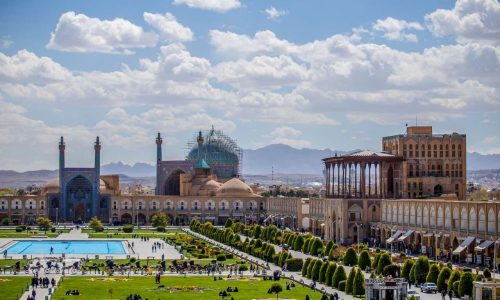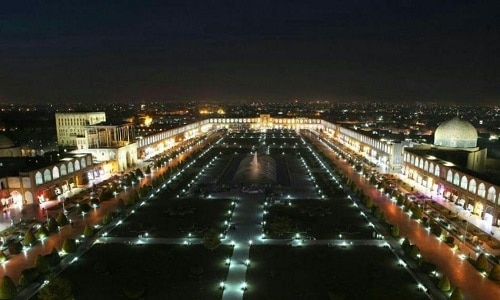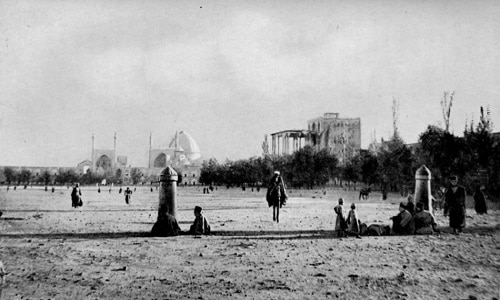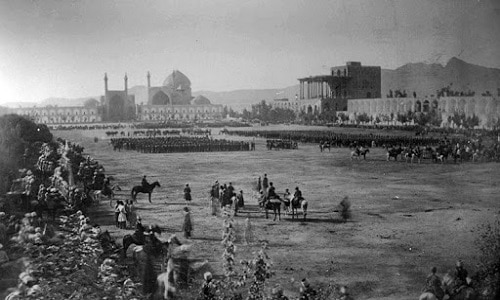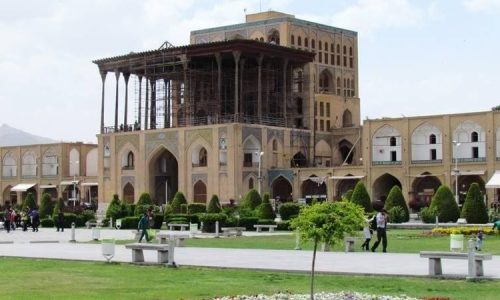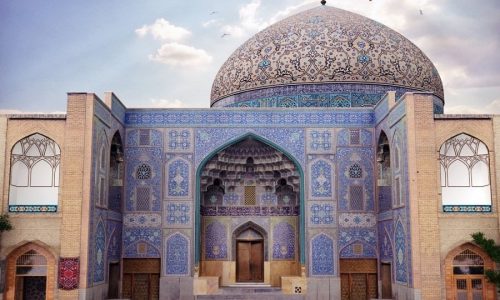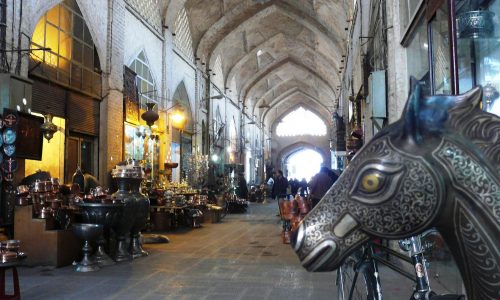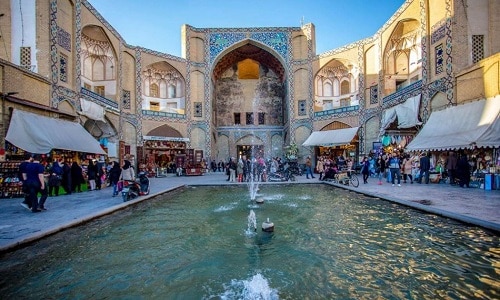Naghsh-E- Jahan Square, now known as Imam Square, is the central square of Isfahan. What distinguishes this square from its counterparts is its rectangular shape, which differs from the circular or oval appearance of many common squares. This rectangular square is 560 meters long and 160 meters wide. To understand the vastness and charm of Imam Square, it is enough to know that it is wider than Moscow Red Square, which is one of the widest and most famous squares in the world. The large and famous square of Brussels, Belgium, with dimensions of 68 x 110 meters, occupies an area of less than one tenth of Naghsh-E- Jahan square. Naghsh-E- Jahan Square has a historical advantage compared to Concorde Square in Paris and is also known as the second largest square in the world after Tiananmen Square in Beijing.
This square has several historical monuments in its arms; That is why by visiting this square, you will mark with a few arrows and you will see an important part of Isfahan’s historical treasure. Naghsh-E- Jahan Square has been registered in the list of national monuments of Iran on February 6, 1961, number 102. This square is one of the first Iranian monuments whose name has been on the UNESCO World Heritage List since October 26, 1979 (No. 26, 1979) with the number 115, and the following criteria have been proposed for its registration:
- It is a masterpiece that shows human genius and creativity.
- It is a prominent example of the interaction between humans and the environment or it can be mentioned as a representative of a culture.
- Directly related to life events or traditions, thoughts and ideas, important works of art or literature of the world.
History of Naqsh-E Jahan Square
The Safavids first chose Tabriz and then Qazvin as their capital, and after a while decided to change it to Isfahan. Before the transfer of the capital took place, there was a large garden in the square called Naqsh-e Jahan, which has been location of government buildings and the palaces of the Timurid rulers and Aghquyunlus. On the west side of the square, at the site of the Aali Qapo construction site, was the garden section of the garden, which was known as the door of the pavilion. During the Seljuk period, this place was called Kushk (pavilion) Square, and the arrest of the Barkiarq, the fifth king of the Seljuk dynasty, by his brother, Mahmud, took place there. Kushk Square was also the place of execution of convicts and holding of some official rituals such as Nowruz celebration and for this reason it was very important.
Safavid era
In the early days of his reign, Shah Abbas I expanded the square, and lights and fireworks were often performed there. Various historical sources consider the modern building of the square to belong to the reign of Shah Abbas I and the year 1011 AH. On the head of Sheikh Lotfollah Mosque and the Grand Mosque in the square, two names of Master as the most beautiful square in the world. During the reign of Shah Abbas II, the overcrowding of the surrounding bazaar and vendors led to the construction of another square. This square, which was located very close to the old square and behind the Sheikh Lotfollah Mosque, was initially called the New Square, and because the old mansion in Naqsh-E Jahan Garden was demolished at the same time as the construction of this square, its materials were used in construction of this new square. This new square was also called Naqsh-E Jahan Square. According to Chardin, a French tourist, up to 50,000 lights were lit in the square during the festivities, and its beauty reached its peak. The detailed description of this square has been written and praised by other famous European tourists such as Jean-Baptiste Tavernier, Pietro Delavalle, Sanson, Engelbert Kempfer, etc.
who have visited Isfahan since the Safavid era and praised its beauty. Evidence suggests that during the construction period of the square and then throughout the Safavid period, the square had an active function, but during the reign of Shah Suleiman and Shah Sultan Hussein, the attention of the square was gradually reduced. Mohammad Reza and Master Ali Akbar Isfahani can be seen. These are the two architects who designed the Imam square and built it in its current form. This square was one of the largest squares in the world in the 11th century AH, equal to the 17th century AD, and the French knight Jean Chardin has introduced it
Qajar era
With the coming to power of the Qajar, this square, like other historical monuments in Isfahan, was neglected and parts of the square were destroyed during the turmoil of Iran from the invasion of Ashraf Afghan to the establishment of the Qajar government. The bell tower of the gate of Caesarea was destroyed during the Qajar period and the former prosperity did not return to the square. During the reign of some local rulers such as Prince Zell- Al-Sultan and Prince Sarem- Al-Dawlah, the Naghsh Jahan Square complex was on the verge of extinction. And at the end of the Qajar period, most of the cells and pavilions were destroyed and the tiling of the domes was broken and the square needed immediate repair.
Pahlavi era
With the coming to power of the Pahlavi, a new era for the square began and repairs were made. These repairs have been going on since then to preserve this eye-catching attraction. After the restoration of the square and the buildings around it during the reign of Reza Shah, the official name of this square was changed to Shah Square and the Grand Abbasid Mosque was renamed Shah Mosque.
After the Islamic Revolution
After the Islamic Revolution of Iran, the official name of this square was changed to Imam Square or Imam Khomeini Square. It is interesting to know that this square was initially about 100,000 square meters and with the changes that have taken place over time and the addition of a row of cells around it, it has been reduced by about 20,000 meters. Today, this square is not only a historical and local attraction for people to have fun, but also a place for important gatherings.
Sights of Imam Square
By entering the Naqsh-E Jahan, you enter a different atmosphere of it. This square has a large pool in the middle of which the beauty of its fountain dance is famous in general and in particular. Numerous passages allow you to easily move around the square and enjoy the beauty. On both sides of the square are religious buildings and mosques, and on the other side is a spectacular palace. The entrance of Isfahan Bazaar is from Imam square that invites you to a historical and different world. Around the square, there are stalls or shops that offer pure handicrafts and dazzle your eyes with their goods. In the following, a brief introduction of historical monuments around the square is given. For more information about each of these buildings, refer to the given links.
Aali Qapo Palace
One of the most eye-catching buildings in the Naghsh-E-Jahan square is the Aali Qapo Palace, which is located on its western side and invites you to its inner world with a charming appearance. This mansion is 48 meters high and has 6 floors that lead to each other with spiral stairs.
Sheikh Lotfollah Mosque
In a corner of this historic square, the beautiful dome of a mosque attracts the attention of every passer-by, because unlike other mosques whose minarets have gone to the blue sky, no minaret can be seen above it. Sheikh Lotfollah Mosque is one of the special mosques in Iran that was built during the Safavid era and today has many fans as one of the sights of the Naghsh-E- Jahan complex.
Isfahan Grand Bazaar
Isfahan Bazaar is one of the largest and most beautiful bazaars in Iran and due to its presence in Naqhsh-E Jahan Square, it is one of the most privileged bazaars in Iran in terms of tourism. The construction of the main building of this bazaar and its different parts lasted from the tenth to the thirteenth century and was completed in the Safavid and Qajar eras.
Gate of Caesarea and Caesarea Bazaar
Qaisaria Gate is the name of one of the structures of the Safavid era, which is located in a corner of Naqsh-E Jahan Square and at the main entrance of Isfahan Bazaar, and after experiencing the vicissitudes of fortune, it still stands firmly in its place. In the past, this building had 3 floors, but after the demolition of one of the floors, only two floors of this building remain. Part of Isfahan Grand Bazaar is known as Qaisaria Bazaar, the entrance of which is located in Naqsh-E Jahan Square, marked by gate of Qaisaria.
Polo gates
On the south and north sides of Naqsh-e jahan Square, there are short and stone pillars that actually formed the polo gate, and today passers-by pass by them indifferently. These are relics of polo in the past and are the oldest polo gates in the world.
Other entertainment in Imam Square
Naqsh-e Jahan Square is not only a place to explore the history of this land, but you can also think about having fun in it and create different moments for yourself:
Shopping: Isfahan Grand Bazaar and the rooms around Imam Square have created good opportunities for tourists to buy souvenirs and handicrafts and many other things. In these bazaars, you can see and buy different handicrafts of Isfahan, including various types of kilims and carpets, copper utensils, silver utensils, etc.
Round belly: Among the rooms and shops in Naqsh-e Jahan Square, you can try delicious porridge, traditional Isfahan ice cream, or a combination of doogh and baklava, which is a traditional food of people of Isfahan. Do not forget the ice cream and juice shops, especially in summer, when you may be tired of the heat.
Carriage rides: One of the special effects of Naghsh-e- Jahan Square are the carriages that spin around the square and give you a different kind of sightseeing. These carriages take you away from the present for a moment and take you to a historical atmosphere.
Photography: Pure subjects are seen everywhere in this field and allow you to capture the most beautiful and lasting images. From the beautiful domes of mosques to water fountains and architectural effects, etc., all of them, can fit in the picture frame.
Cost and time table to visit Naqsh-e Jahan
Ticket price: free
Opening hours: 24 hours a day
English and Farsi address of Naqsh-e Jahan
Naqsh-e Jahan square, Isfahan
اصفهان، میدان نقش جهان






